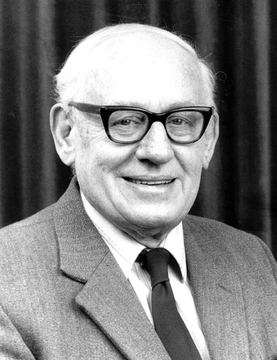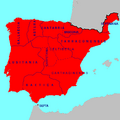E. A. Thompson facts for kids
Quick facts for kids
E. A. Thompson
|
|
|---|---|
 |
|
| Born |
Edward Arthur Thompson
22 May 1914 Waterford, Ireland
|
| Died | 1 January 1994 (aged 79) Nottingham, England
|
| Nationality | British |
| Education | Trinity College, Dublin |
| Spouse(s) |
|
| Scientific career | |
| Institutions |
|
| Academic advisors | H. W. Parker |
| Influenced |
|
Edward Arthur Thompson (born May 22, 1914 – died January 1, 1994) was a famous British historian. He was born in Ireland. Thompson studied classics (ancient Greek and Roman history and culture) and medieval studies (the Middle Ages). He was a professor at the University of Nottingham for many years.
Thompson was one of the first to study a period called late antiquity. This time period is between the end of the Roman Empire and the start of the Middle Ages. He was very interested in how the Romans interacted with groups like the Huns and Visigoths. These groups were sometimes called "barbarians" by the Romans. Thompson's work helped people learn more about the history of early Germanic peoples. His books and ideas are still very important today.
Contents
Edward Arthur Thompson's Early Life
Edward Arthur Thompson was born on May 22, 1914, in Waterford, Ireland. His family was very religious, following the Presbyterian faith. His father, Robert James Thompson, worked for health insurance. His mother, Margaret Murison, was from Scotland.
In 1922, his family moved to Dublin. Edward went to The High School, Dublin. After high school, he went to Trinity College, Dublin. He earned a special scholarship called a sizarship. This meant he got help with his college costs. He was the first person in his family to go to university. His father hoped he would become a minister, but Edward chose a different path.
He studied classics and graduated with top honors in 1936. He later said his high school headmaster helped him choose this subject. He also earned another degree, a BLitt, focusing on the Arcadian League.
From 1937 to 1938, Thompson studied in Berlin, Germany. While there, he saw the rise of Nazism. He strongly disliked it. He once saw a Nazi group break into a shop and beat the owner. These experiences made him careful when studying Germanic peoples later in his career.
Starting His Career as a Historian
In 1939, Thompson became a lecturer (a type of teacher) in classics at Trinity College, Dublin. He stayed there for a few years.
During World War II, Thompson wanted to join the British Army. But instead, he got a job at the University of Swansea in 1941. He later moved to King's College, London, where he taught classics from 1945 to 1948.
His first book, Ammianus Marcellinus (published in 1947), was very important. It helped restart the study of late antiquity in the United Kingdom. His next book, A History of Attila and the Huns (1948), was also very popular. Both books were reprinted and were used as standard guides for many years. From the late 1940s, Thompson focused all his studies on late antiquity.
Working at the University of Nottingham

In 1948, Thompson moved again to lead the classics department at the University of Nottingham. He worked there from 1948 to 1979. During this time, he became a very important person in the study of late antiquity in the UK. Nottingham became a top place for this kind of study. Thompson focused mostly on research and teaching.
In 1951, Thompson published A Roman Reformer and Inventor. This book looked at an unknown writer of a work called De rebus bellicis. Thompson's book helped set up how people study this work today.
By the early 1950s, Thompson started focusing more on early Germanic peoples. Not many people in English-speaking countries were studying this topic then. Thompson wanted to study them without any unfair ideas. His dislike for Nazism likely influenced his careful approach. His work was groundbreaking in Germanic studies. He helped remove old, biased ideas from the field.
In 1965, Thompson published The Early Germans. This book looked at how Germanic societies changed when they met the Roman Empire. He thought that the Roman Empire made Germanic societies more divided by social classes. He was also very interested in how Germanic peoples became Christians. He studied the differences between those who followed Arianism and those who followed Roman Catholicism.
His next big studies were The Visigoths in the Time of Ulfila (1965) and The Goths in Spain (1969). These books focused on the Visigoths. His books on early Germanic peoples, especially the Visigoths, quickly became key books on the subject. They were still highly respected when he passed away. Thompson's studies on the Visigoths looked at how different groups within Visigothic society interacted with the Roman people they lived among. He believed that Visigothic leaders wanted to fit in with Roman society, but ordinary Visigoths wanted to change it completely.
Thompson was the first chairman of the editorial board for the journal Nottingham Medieval Studies. He led it from 1957 until he retired in 1979. Under his leadership, it became a major journal in its field. In 1964, Thompson was chosen as a Fellow of the British Academy. This was a great honor. He was the first academic from the University of Nottingham to receive it.
Later Years
Thompson retired from the University of Nottingham in 1979. After retiring, he spent a year at the University of Wisconsin in the United States. There, he wrote four important papers. These were later put together in a book called Romans and Barbarians: The Decline of the Western Empire (1982).
After this, Thompson started to focus on the end of Roman Britain. He wrote two books on this topic: Saint Germanus of Auxerre and the End of Roman Britain (1984) and Who Was Saint Patrick? (1985). In his studies of post-Roman Britain, Thompson believed that old writings showed that the Anglo-Saxon settlement of Britain involved a lot of change and disruption. Edward Arthur Thompson passed away in Nottingham on January 1, 1994.
His Political Views
Thompson's strong dislike for Nazism and his rejection of his family's strict religious views made him interested in Marxist ideas. These ideas were popular among thinkers in the 1930s. He was especially impressed by the writings of Friedrich Engels and Vladimir Lenin.
By 1941, Thompson joined the Communist Party of Great Britain. His Marxist ideas can be seen in many of his historical works. For example, they influenced his studies on the rebellions of the Bagaudae.
Thompson left the Communist Party of Great Britain in 1956. This was the year the Soviet Union sent troops into Hungary. Later in life, he said he was more of a "Thompsonist" than a Marxist. However, his academic work still showed a Marxist way of looking at history. The idea of social classes in societies remained very important in his studies. He was very interested in politics, even though he was no longer actively involved. He strongly disagreed with how the Soviet Union handled the Prague Spring in 1968. He also criticized British policies in Northern Ireland.
Personal Life
While teaching at King's College, Thompson met his first wife, Thelma Marjorie Phelps, who was a doctor. They got married in 1945 and had a son and a daughter. They separated in 1958. In 1964, he married Hazel Joyce Casken. They had a daughter and stayed together until his death.
See also
 In Spanish: Edward Arthur Thompson para niños
In Spanish: Edward Arthur Thompson para niños
- Herwig Wolfram
Images for kids



